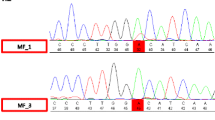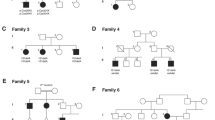Abstract
SYNJ1 has been recently identified by two independent groups as the gene defective in a novel form of autosomal recessive, early-onset atypical parkinsonism (PARK20). Two consanguineous families were initially reported (one of Sicilian and one of Iranian origins), with the same SYNJ1 homozygous mutation (c.773G > A, p.Arg258Gln) segregating with a similar phenotype of early-onset parkinsonism and additional atypical features. Here, we report the identification of the same SYNJ1 homozygous mutation in two affected siblings of a third pedigree. Both siblings had mild developmental psychomotor delay, followed, during the third decade of life, by progressive parkinsonism, dystonia, and mild cognitive impairment. One sibling suffered one episode of generalized seizures. Neuroimaging studies revealed severe nigrostriatal dopaminergic defects, mild striatal and very mild cortical hypometabolism. Treatment with dopamine agonists and anticholinergics resulted in partial improvements. Genetic analyses revealed in both siblings the SYNJ1 homozygous c.773G > A (p.Arg258Gln) mutation. Haplotype analysis suggests that the mutation has arisen independently in this family and the Sicilian PARK20 family previously described by us, in keeping with the hypothesis of a mutational hot spot. This is the third reported family with autosomal recessive, early-onset parkinsonism associated with the SYNJ1 p.Arg258Gln mutation. This work contributes to the definition of the genetic and clinical aspects of PARK20. This newly recognized form must be considered in the diagnostic work-up of patients with early-onset atypical parkinsonism. The presence of seizures might represent a red flag to suspect PARK20.


Similar content being viewed by others
References
Bonifati V (2014) Genetics of Parkinson’s disease—state of the art, 2013. Parkinsonism Relat Disord 20(Suppl 1):S23–S28. doi:10.1016/S1353-8020(13)70009-9
Quadri M, Fang M, Picillo M, Olgiati S, Breedveld GJ, Graafland J, Wu B, Xu F, Erro R, Amboni M, Pappata S, Quarantelli M, Annesi G, Quattrone A, Chien HF, Barbosa ER, International Parkinsonism Genetics N, Oostra BA, Barone P, Wang J, Bonifati V (2013) Mutation in the SYNJ1 gene associated with autosomal recessive, early-onset Parkinsonism. Hum Mutat 34(9):1208–1215. doi:10.1002/humu.22373
Krebs CE, Karkheiran S, Powell JC, Cao M, Makarov V, Darvish H, Di Paolo G, Walker RH, Shahidi GA, Buxbaum JD, De Camilli P, Yue Z, Paisan-Ruiz C (2013) The Sac1 domain of SYNJ1 identified mutated in a family with early-onset progressive Parkinsonism with generalized seizures. Hum Mutat 34(9):1200–1207. doi:10.1002/humu.22372
Varrone A, Salvatore E, De Michele G, Barone P, Sansone V, Pellecchia MT, Castaldo I, Coppola G, Brunetti A, Salvatore M, Pappata S, Filla A (2004) Reduced striatal [123 I]FP-CIT binding in SCA2 patients without parkinsonism. Ann Neurol 55(3):426–430. doi:10.1002/ana.20054
Barrett JC, Fry B, Maller J, Daly MJ (2005) Haploview: analysis and visualization of LD and haplotype maps. Bioinformatics 21(2):263–265. doi:10.1093/bioinformatics/bth457
Bertoli-Avella AM, Giroud-Benitez JL, Akyol A, Barbosa E, Schaap O, van der Linde HC, Martignoni E, Lopiano L, Lamberti P, Fincati E, Antonini A, Stocchi F, Montagna P, Squitieri F, Marini P, Abbruzzese G, Fabbrini G, Marconi R, Dalla Libera A, Trianni G, Guidi M, De Gaetano A, Boff Maegawa G, De Leo A, Gallai V, de Rosa G, Vanacore N, Meco G, van Duijn CM, Oostra BA, Heutink P, Bonifati V (2005) Novel parkin mutations detected in patients with early-onset Parkinson’s disease. Mov Disord 20(4):424–431. doi:10.1002/mds.20343
Bruggemann N, Mitterer M, Lanthaler AJ, Djarmati A, Hagenah J, Wiegers K, Winkler S, Pawlack H, Lohnau T, Pramstaller PP, Klein C, Lohmann K (2009) Frequency of heterozygous Parkin mutations in healthy subjects: need for careful prospective follow-up examination of mutation carriers. Parkinsonism Relat Disord 15(6):425–429. doi:10.1016/j.parkreldis.2008.11.014
Brooks J, Ding J, Simon-Sanchez J, Paisan-Ruiz C, Singleton AB, Scholz SW (2009) Parkin and PINK1 mutations in early-onset Parkinson’s disease: comprehensive screening in publicly available cases and control. J Med Genet 46(6):375–381. doi:10.1136/jmg.2008.063917
Matta S, Van Kolen K, da Cunha R, van den Bogaart G, Mandemakers W, Miskiewicz K, De Bock PJ, Morais VA, Vilain S, Haddad D, Delbroek L, Swerts J, Chavez-Gutierrez L, Esposito G, Daneels G, Karran E, Holt M, Gevaert K, Moechars DW, De Strooper B, Verstreken P (2012) LRRK2 controls an EndoA phosphorylation cycle in synaptic endocytosis. Neuron 75(6):1008–1021. doi:10.1016/j.neuron.2012.08.022
Trempe JF, Chen CX, Grenier K, Camacho EM, Kozlov G, McPherson PS, Gehring K, Fon EA (2009) SH3 domains from a subset of BAR proteins define a Ubl-binding domain and implicate parkin in synaptic ubiquitination. Mol Cell 36(6):1034–1047. doi:10.1016/j.molcel.2009.11.021
Ben Gedalya T, Loeb V, Israeli E, Altschuler Y, Selkoe DJ, Sharon R (2009) Alpha-synuclein and polyunsaturated fatty acids promote clathrin-mediated endocytosis and synaptic vesicle recycling. Traffic 10(2):218–234. doi:10.1111/j.1600-0854.2008.00853.x
Nemani VM, Lu W, Berge V, Nakamura K, Onoa B, Lee MK, Chaudhry FA, Nicoll RA, Edwards RH (2010) Increased expression of alpha-synuclein reduces neurotransmitter release by inhibiting synaptic vesicle reclustering after endocytosis. Neuron 65(1):66–79. doi:10.1016/j.neuron.2009.12.023
Vilarino-Guell C, Wider C, Ross OA, Dachsel JC, Kachergus JM, Lincoln SJ, Soto-Ortolaza AI, Cobb SA, Wilhoite GJ, Bacon JA, Behrouz B, Melrose HL, Hentati E, Puschmann A, Evans DM, Conibear E, Wasserman WW, Aasly JO, Burkhard PR, Djaldetti R, Ghika J, Hentati F, Krygowska-Wajs A, Lynch T, Melamed E, Rajput A, Rajput AH, Solida A, Wu RM, Uitti RJ, Wszolek ZK, Vingerhoets F, Farrer MJ (2011) VPS35 mutations in Parkinson disease. Am J Hum Genet 89(1):162–167. doi:10.1016/j.ajhg.2011.06.001
Zimprich A, Benet-Pages A, Struhal W, Graf E, Eck SH, Offman MN, Haubenberger D, Spielberger S, Schulte EC, Lichtner P, Rossle SC, Klopp N, Wolf E, Seppi K, Pirker W, Presslauer S, Mollenhauer B, Katzenschlager R, Foki T, Hotzy C, Reinthaler E, Harutyunyan A, Kralovics R, Peters A, Zimprich F, Brucke T, Poewe W, Auff E, Trenkwalder C, Rost B, Ransmayr G, Winkelmann J, Meitinger T, Strom TM (2011) A mutation in VPS35, encoding a subunit of the retromer complex, causes late-onset Parkinson disease. Am J Hum Genet 89(1):168–175. doi:10.1016/j.ajhg.2011.06.008
Edvardson S, Cinnamon Y, Ta-Shma A, Shaag A, Yim YI, Zenvirt S, Jalas C, Lesage S, Brice A, Taraboulos A, Kaestner KH, Greene LE, Elpeleg O (2012) A deleterious mutation in DNAJC6 encoding the neuronal-specific clathrin-uncoating co-chaperone auxilin, is associated with juvenile parkinsonism. PLoS One 7(5):e36458. doi:10.1371/journal.pone.0036458
Koroglu C, Baysal L, Cetinkaya M, Karasoy H, Tolun A (2013) DNAJC6 is responsible for juvenile parkinsonism with phenotypic variability. Parkinsonism Relat Disord 19(3):320–324. doi:10.1016/j.parkreldis.2012.11.006
Disclosure
This study was supported by grants from the Stichting ParkinsonFonds (The Netherlands) to V.B. The authors declare that they have no conflict of interest. All experiments performed in this study comply with the current laws of the countries in which they were performed.
Author information
Authors and Affiliations
Corresponding authors
Additional information
Simone Olgiati and Anna De Rosa contributed equally to this work and should be considered as joint first authors.
Giuseppe De Michele and Vincenzo Bonifati contributed equally to this work and should be considered as joint senior authors.
Electronic supplementary material
Below is the link to the electronic supplementary material.
ESM 1
(PDF 664 kb)
The male patient from the Naples family with SYNJ1 mutation (NAPO-41) (MPG 10,980 kb)
The female patient from the Naples family with SYNJ1 mutation (NAPO-42) (MPG 7,690 kb)
Rights and permissions
About this article
Cite this article
Olgiati, S., De Rosa, A., Quadri, M. et al. PARK20 caused by SYNJ1 homozygous Arg258Gln mutation in a new Italian family. Neurogenetics 15, 183–188 (2014). https://doi.org/10.1007/s10048-014-0406-0
Received:
Accepted:
Published:
Issue Date:
DOI: https://doi.org/10.1007/s10048-014-0406-0




